We arrived in Vietnam nicely and in accordance with the timetable, and at the airport we were met by a driver who took us to our hotel. Right at the start, the people at the hotel were exceptionally kind. Not only did they provide us coffee and cookies while we were waiting for the registration formalities to be done, but they also gave us a map and showed us where we were, what was there to be seen, what were the good places for eating, as well as for shopping, and they also called a tour agency we had to go to in order to announce us. And, of course, they showed us on the map where the agency was located. What I want to say is that they were fantastically forthcoming and kind!
When booking the hotel, I chose a place in the Old Quarter of Hanoi where the concentration of tourists is the highest, but this is also a downtown area, so it is easy to do the sightseeing of Hanoi from there. In my plan for this journey, I postponed the true sightseeing of Hanoi for later on and in this first afternoon we had to go to an agency to pay for a tour we were going on already the following morning. And so we did that, but along our way we passed by inevitable shops with fake branded goods (mostly sport clothes and shoes, predominantly for hiking on account of the proximity of mountains and popularity of trekking tours). Still, the goods are so inexpensive, that it does not matter in the least if they are not of the same quality of the original.
But, let me take this opportunity to speak my mind about brands. I do agree that the goods produced by famous companies are often of a better quality than the ones that are not branded (as in branding of livestock). But, let us assume, playing a devil’s advocate, that we have two products that are exactly of the same quality – one with a brand of a well-known company and the other without any such brand. I am absolutely sure that the first one, the one with the brand, would be more expensive. In other words, buyers pay more for the privilege to be able to walk around and advertise companies that at the same time pay enormous figures to some already rich people to advertise them. Am I the only one to whom this does not make any sense at all?
On the other hand, a lot of people love branded things not necessarily due to their quality, but precisely because of the brand itself which creates a feeling in them that they have made it. I get that feeling when I hang around with the people I love – it does not cost me a penny and yet we are all happy and enjoy each other’s company regardless of whether we have any brands on us or not.
But, let me go back to Hanoi. As it turned out, we got there on a Saturday, i.e., during a weekend and this was interesting because there was already a stage installed at a square near Hoan Kiem lake, while the entire central part of the city is closed off for traffic during a weekend and pedestrians take over. It is important to say that the main means of transportation not only in Hanoi, but throughout Vietnam is the motorcycle. These are mostly two-wheelers with less power, but they obviously drive around with no problems. The traffic in general seems to all Westerners as a complete chaos, but the local people apparently know the written and especially the unwritten rules, and it is clear that they find their way around the crowd perfectly. It takes a little time for one to get accustomed to it, but it is not impossible.
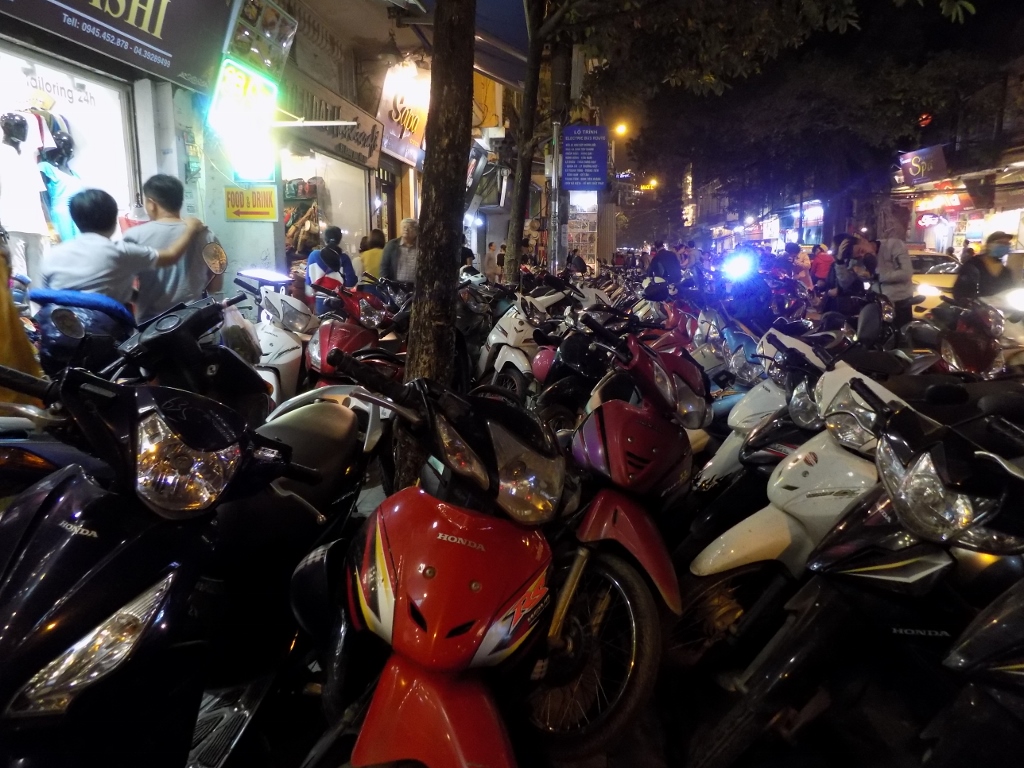 The real bosses in the streets of Vietnam are – motorcycles
The real bosses in the streets of Vietnam are – motorcycles
We first went to the agency I had already contacted from Belgrade, there we agreed on the details and paid, while they insisted on us having something, so we took some watermelon. It had a most amazing aroma. This is simply the well-remembered smell of watermelons that no longer exists in the “developed” countries. I can’t speak for other countries, but in mine, younger generations would have no idea what I’m talking about, but the older ones would remember as soon as they would feel the scent of the watermelons from Vietnam. They are physically smaller than the watermelons that may be bought in Serbia nowadays, but the taste and the smell were awesome.
Afterwards we went to a nearby restaurant where we had a nice meal and then returned to the square with the stage where the concert was in full swing. A young man was singing and he was obviously very popular, for in addition to him we could hear the screams of his female fans even without any loud speakers. And the music was not bad at all.
From that square in the northbound direction there is a street which was completely pedestrian now, just like the entire central part of the city, and along that street there were stalls with different goods. We went along the street and thus we came across, I would say, traditional music, since I have no idea what the songs were about. Then we entered some side streets, a little to the left, a little to the right, again coming across some street music, as well as young dancers, and it was all full of people, with shops selling different goods and restaurants, and we really enjoyed it. I have to say that the streets in the centre of Hanoi are very well marked and by using the map we had obtained at the hotel we found our way around with no problems. Eventually, we went to Hoan Kiem Lake that is located in the downtown area, strolled around it for a while, but then we returned to our hotel, since we had to get up at 6 o’clock the next morning.
Still, here are a few different music styles and shows that we listened to and watched that evening when we walked around Hanoi.
Since the bus was coming to pick us up already at 7 am, as soon as we woke up and packed up, we went downstairs to have breakfast which was fabulous and I immediately dived into different fruits. I have to admit that I don’t understand people when they say they cannot have breakfast early in morning because they are not hungry. Under normal circumstances, I am never hungry this early in the morning, but because of my work I have developed a habit of having breakfast even at 5 am, if necessary. I simply chew food and swallow it. Later, when I need the energy, this all comes in handy. And, so it was like this, the first morning in Hanoi.
We were picked up by a relatively small bus, but it drove us only little to a bigger coach, since in Hanoi large tourist coaches are not allowed to enter the old part of the city. So, I put my big backpack into the baggage hold and when I wanted to enter the coach I was in for a surprise. We all had to take our shoes off before entering and we were given plastic bags to put our shoes in. Namely, this was a coach with two-level semi-inclined seats and we could walk there only barefoot or in socks. I was puzzled at first, but soon got used to it. Since I am tall, the seat was not quite my size, but I soon adjusted to that as well. The semi-inclined seats are arranged in three columns and at two levels, and the passengers also get blankets to provide additional warmth if necessary.
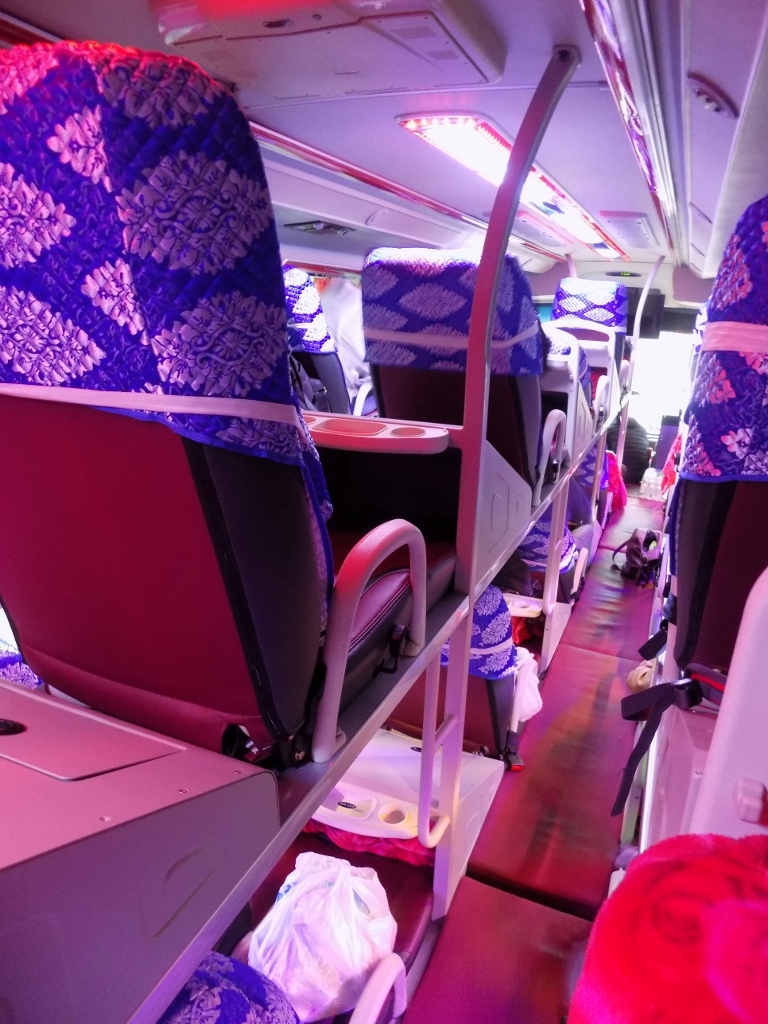 In interior of the coach to Sa Pa
In interior of the coach to Sa Pa
The route of our visits in the north part of Vietnam
With breaks, the trip lasted for around 6 hours and it took us to a place in the north called Sa Pa. Sa Pa is a popular tourist destination mostly for trekking, since it is located high in the mountains and close to even higher mountains. Specifically, Sa Pa is located at around 1500 m above sea level and there are also peaks over 3000 m a.s.l. in its vicinity. The temperature may easily drop below zero, i.e., it can actually be quite cold there. Moreover, when we were there, it was even colder than in Belgrade in January, but this was because it was unusually warm in Belgrade for this time of the year. I was mostly inspired to go and visit Sa Pa by the fact that there are some carved stones there which are in the UNESCO’s Tentative World Heritage List. Still, I had an impression that this is a rather neglected fact, since Sa Pa is primarily known for its terraced rice fields which are passed by during the trekking.
During the trip it was constantly cloudy, but dry. The forecast had said that the probability of rain in Sa Pa that day was 20%. And here I have to say that I know what probability is in statistics, but… When it comes to rain, the probability is always 50:50 – it is either going to rain or it is not.
As we entered Sa Pa, we could see some nice buildings and a small lake in the centre, but as the coach parked at the central square near a church, the clouds apparently came down, it started to rain and it actually didn’t stop at all that day, but at this particular point in time we still had no idea what was to come.
To start with, we were met by the coach by Chai, our guide, who is a member of the H’Mong tribe. First we got our backpacks and went under the canopy above the entrance into the church. There we discussed with Chai if we wanted to go to her house by taxi, since our tour included private accommodation (homestay), or if we wanted to do some trekking. Somehow for us it was really important to see the stones and when we mentioned it to her, at first she had no idea what we were talking about, but when we explained, she got it and said there were these stones precisely in her village, i.e., where we were going to stay. Then we said we would like to do some trekking. As it turned out, she was the guide only for the two of us. Sa Pa is mostly visited by the young, so it was good that the two of us, at least young at heart, could go alone and at our own pace. To start with, we sent the big backpacks home by a motorcycle ridden by Chai’s son.
And so we started to follow tiny Chai who first took us to a local restaurant where we had lunch. We opted for two versions of fried noodles with meat and vegetables. This is in a way the simplest choice, but other than being tasty, it also includes everything one needs.
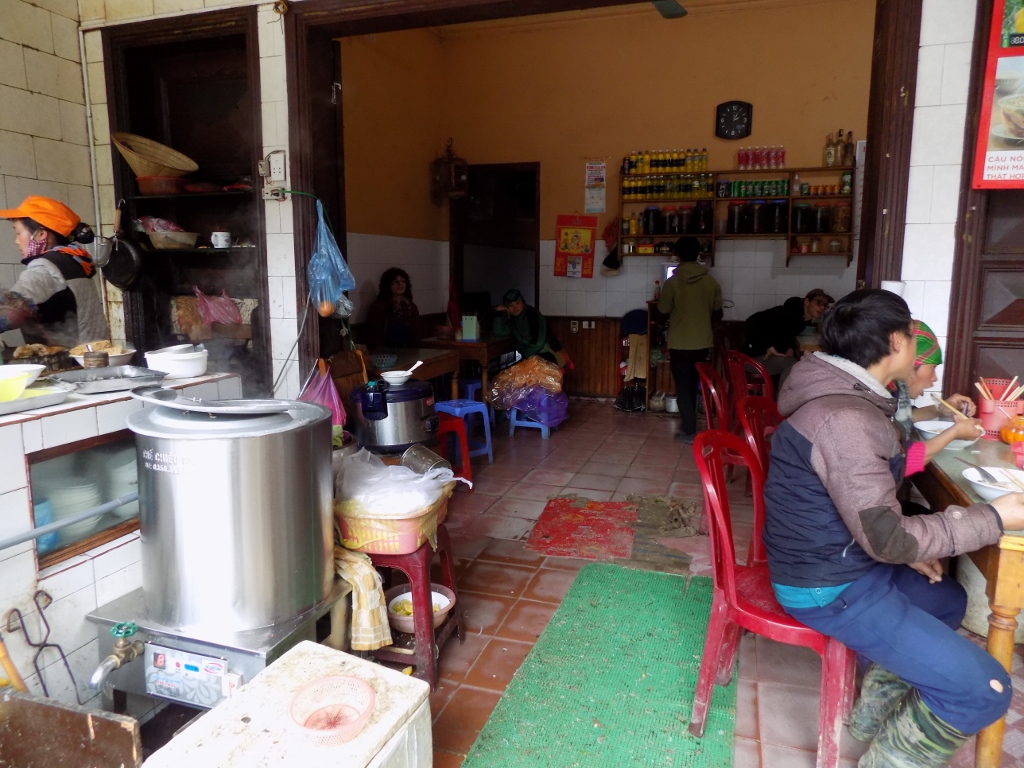 Restaurant in Sa Pa where we had our lunch
Restaurant in Sa Pa where we had our lunch
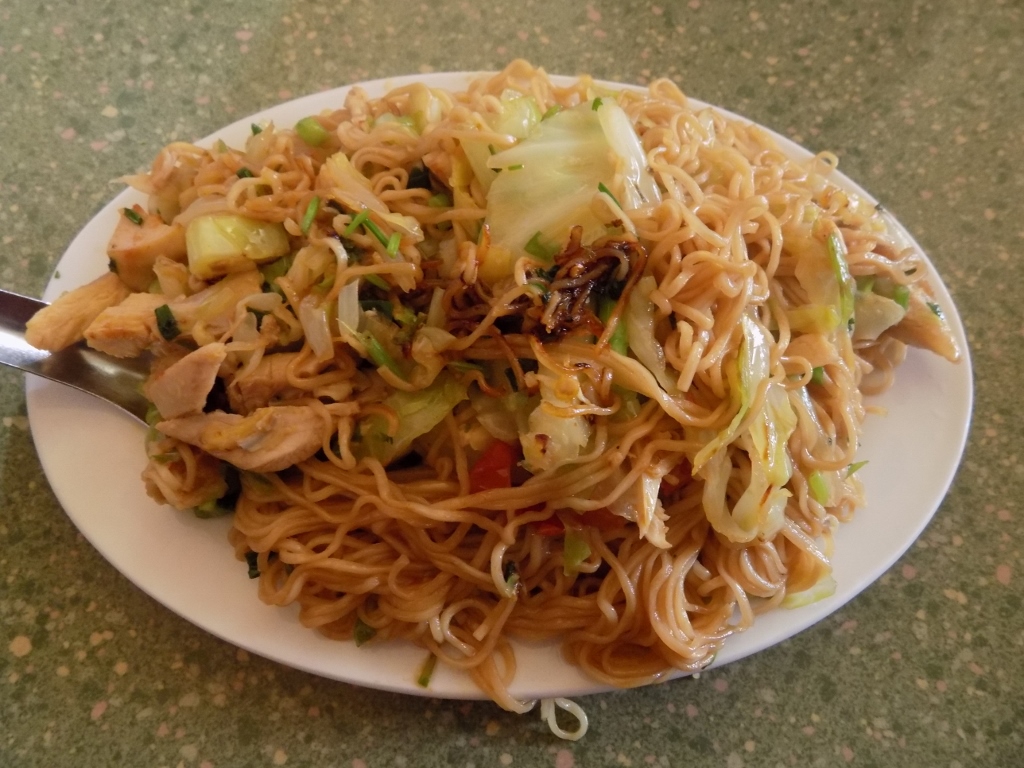 Fried noodles with chicken and vegetables
Fried noodles with chicken and vegetables
And then we started with our “trekking.” While we were still in Sa Pa, the road or perhaps the sheer luck took us by a shop with jackets and there Sneza saw something she liked, so we stopped there for a minute or two. By the way, I had already remembered in Hanoi that we should buy nylon raincoats with a hood that were large enough to cover both the person wearing them, as well as a backpack or a small backpack, as was our case. Because it’s no use having a good rain jacket if the backpack and everything inside of it are wet. In addition, these raincoats went down approximately to the level of mid-thighs.
While Sneza was looking at jackets, I happened to notice in a basket with nylon raincoats, which can obviously be bought in Sa Pa as well, some nylon-plastic boots. I had already asked Chai if our footwear (trainers) was suitable for where we were heading and she casually said they were (she herself had wellingtons), but taking into account that it was already raining all the time, I started to look at these so-called boots more carefully. Then Chai proposed that perhaps we may buy the “boots” after all, but only the model made solely of nylon, as these were apparently better, so Sneza and I bought two pairs. I was quite suspicious, thinking that we would be sliding in them for sure. Be as it may, soon we left the asphalt road and headed along an unpaved path.
There Chai told us to put on our “boots.” So, these are nylons covers in the shape of boots that go knee-high and on top there is a thin rubber band which ensures that they stay in place without sliding down the calf. They are put on over the shoes and the material is basically a thicker nylon. We really needed this, since we had already started to come across some serious mud along the path we were on. There I saw that the nylon did not slip as I had thought it would. What it would all have looked like, if we hadn’t had these nylon boots on when walking in our trainers through yellowish, thick mud, well, I didn’t even want to imagine that.
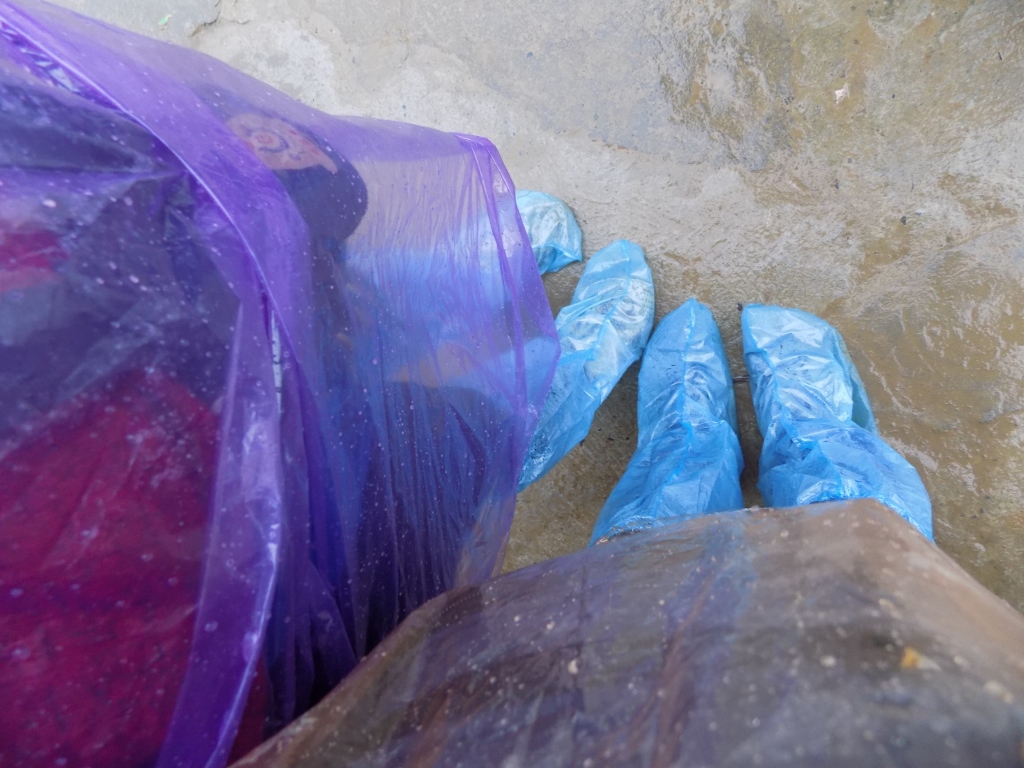 Ready for walking in the rain in Sa Pa
Ready for walking in the rain in Sa Pa
The path first took us through the middle of a cemetery, but we were just too busy looking ahead of us and watching where we were stepping, since there were occasional puddles, to be bothered with the surroundings. Soon we started to descend down a slope and there we had to drag lest we slipped and sat down in mud. Still, we somehow managed to get down to a road, thus reaching asphalt and then we never went back to any unpaved trail. I guess that by that time Chai had a perfect picture of who she was dealing with and that we would never reach her house if we continued along some side paths.
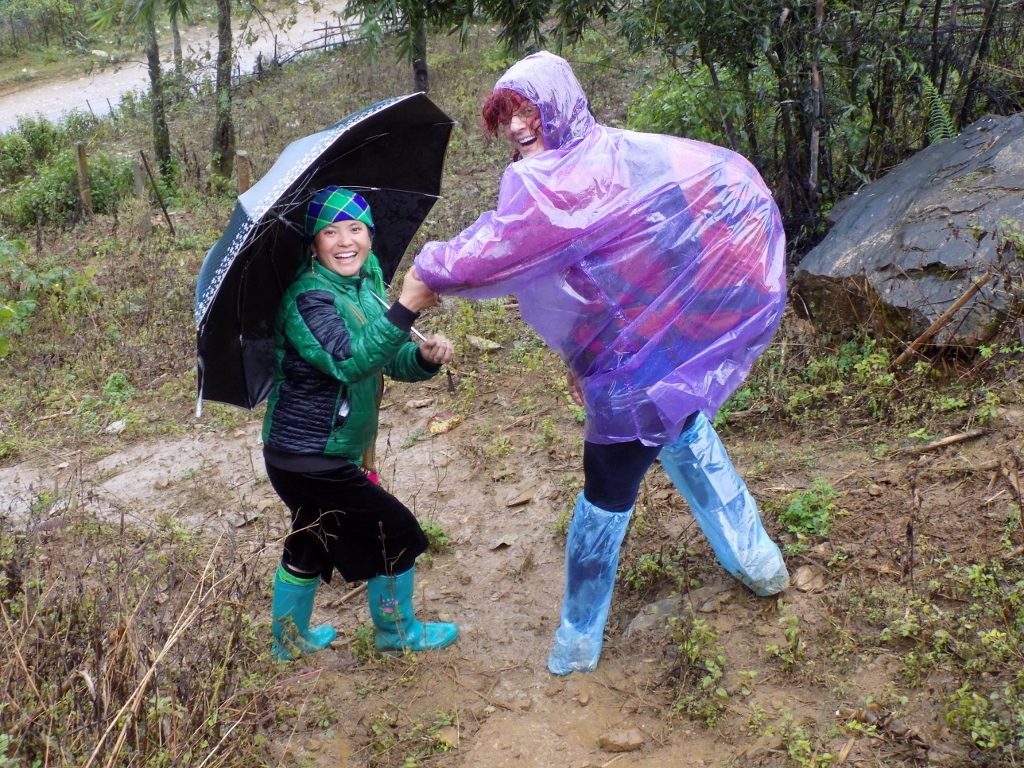 Chai and Sneza
Chai and Sneza
So, we bravely continued going down a local road heading for Chai’s village and it just kept raining all the time while everything around us was in mist. We actually walked through rain clouds and except for the road in front of us, there was absolutely nothing that could be seen sideways except for the clouds. And we were supposed to see terraced paddies or rice fields.
Sa Pa is famous for its terraced paddies. When you type Sa Pa on the internet, the first pictures you see are photos of beautiful sunny, green or yellowish landscapes. Yes. Somewhere in May or June, the rice is all young and green, and such are the rice fields. In August, September and October, the rice ripens and is harvested. But… We came here in the middle of the winter, when it can be sunny, but this was not the case during the two days we spent here. In addition, in this season, the paddies are all covered in mud with stubbles.